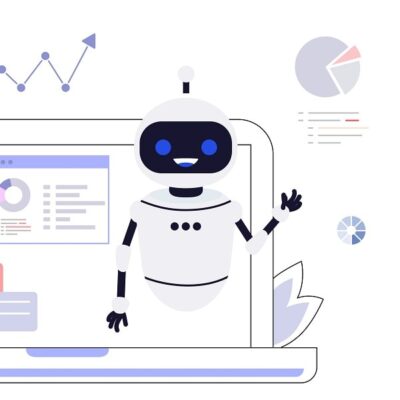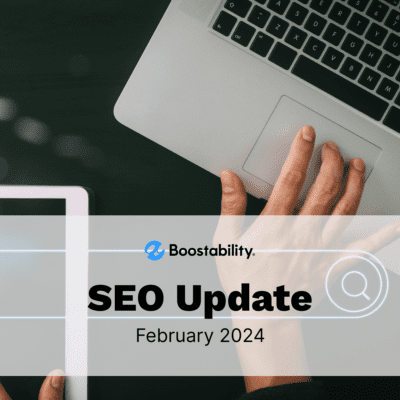Boostability is the Global Leader in Small Business and Partner focused White Label SEO and we get 86% of our customers on the 1st page of Google within 6 months. Our SEO experts Colton Miller and Mike Marsh walked us through the top 5 ways for your business to achieve page one ranking as well as actionable changes your business can implement on your website to make it irresistible for search engines.
Watch the broadcast here, or read on for some of the key takeaways.
The Power of SEO
In 2019, Boostability made updates to our own SEO strategy with growth in mind. We wanted to improve not only our branding and online presence but our content and website, as well. In order to do this, we needed to re-evaluate what our focus was and pivot towards our goal.
This goal included improving many of the very same things other businesses and search engines look at as ranking factors. This includes stats like:
- Time on Page
- Page Views
- High-Intent Keywords
- Article Quality
- Organic Traffic, Which Equals Organic Leads
Just last year, our content marketing team completed a new and improved implementation of the one main strategy. With success seen as an overall increase in organic leads by 67% in 2020 and a big increase in blog user metrics. Because of these stats we could see that our strategy was really paying off. This rise we’ve seen goes to show that SEO works. And when you do SEO right, it REALLY works. That’s the Power of SEO.
During this time we implemented strategies like a renewed keyword research effort and internal linking structure that helped bring attention to our content. We’ve also made sure that every piece of content that we put out is syndicated to our newsletter and social media channels. We had a goal of not only increasing those metrics but to also capture more qualified leads.
As many digital marketers will tell you, organic leads are some of the best leads to land. They traditionally convert at the highest percentage better than any other channel.
So using the power of SEO and the #1 factor to rank on Google is well worth your time. So what are the top factors?
Top 5 Factors to Rank on Google
5 – SEO Friendly Strategy
You want to be topically focused. Use your own tone and your own voice when creating content for your website. Focus on the right keywords. Use specific keywords for your business. If you’d like some clues into what kinds of keywords your customer-base is searching for, next time you have an appointment ask your customers—how did you find me? What phrases did you search for?
You never want to force your intent. Go with the keywords that fit your, and Google’s search intent. Think outside the box and play with the wording of your keyword phrases. Put yourself in your customers’ shoes. Use your competitors. Look at their website and see what they are doing well and see if there is something that you can do better on your own website.
4 – Implementation
It may sound nebulous, but what implementation encompasses are actions like keyword research, tagging, meta descriptions, URL structures, and quality content strategies. These are actionable changes you or your SEO specialist can implement on your site for a better search experience. Customers are looking for a good search experience. Match the search intent, don’t force it. Include the keywords in your content. If you have outdated content, repurpose and update it.
Optimize your meta descriptions and your images. If you aren’t tagging your post on product pages, the search experience is diminished on your site. When customers search for something on your website, make sure your content has the correct tags on them so when they search, they’ll find the right information. Make sure your blog is mobile-friendly and responsive. Even if not everyone is using mobile, you can expect it to increase in the next few years so you want to be ready for your customers.
3 – Have Something to Share, Make Your Content Interesting
Frame your content in a way that is shareable. This can be in the form of tutorials, industry tips, tricks, or processes specific to your business or service. Post those on your website or social profiles. Users tend to share that content. Tell your story and tell your users about your services and what you do. Let them know what you can do for them. By doing this, it can help you stand out against your competitors.
Remember that helpful things are rarely boring, even if they are, objectively, not as exciting as other industries. Use visuals and videos and make them shareable. If there are important people in your company, interview them and showcase them on your website. Quality content is decided by your audience. Make sure it’s interesting and create more of the content they engage with. Make it easy to navigate. If you want people to dive deeper into your content, link to it and make it easy for them to engage.
2 – Local Optimization
This encompasses things like targeting locals packs, citation building, and claiming your Google My Business profile. By doing this you can have more control over your brand and really work with the search engine to find local traffic. When trying to rank locally you need to take proximity, relevance, and prominence into account:
Proximity: How close is your business to the searcher?
Relevance: How relevant to the search query are your products and services?
Prominence: What do other consumers say about your products and services?
All these items have their own potential to get your high-quality local traffic in your area but remember, when optimizing your site for local SEO your main tool for ranking is your content.
1 – Good Content
Content is king. Nothing is more powerful than quality content. But using your content correctly with algorithms from Google that are getting smarter and smarter means that we need to adapt our content for the wins, as well. Make sure to include the following SEO optimizations:
- Keywords – High intent keywords will bring qualified traffic to your site that will convert into leads.
- Intent – Always take into account the intent of each user and where they might be in the funnel. If they aren’t ready to buy then lead them down that path with content.
- Target Audience – Knowing your targeted audience allows you to craft tailored content for each stage of the customer journey.
- Evergreen – put that evergreen content out there for your users. Show your customers what you do and how well you do it. Cite high quality, accurate, and current information in your content.
- Length – Choose the right length for your blogs and content depending on your topic and industry. You need substantial content on your page.
E-A-T (Expertise, Authority, Trustworthiness) – Position yourself as an expert in your industry. Create content, tips, information to show you are an expert in what you do.
For all future shows be sure to sign up right here and check out all our other amazing content!










